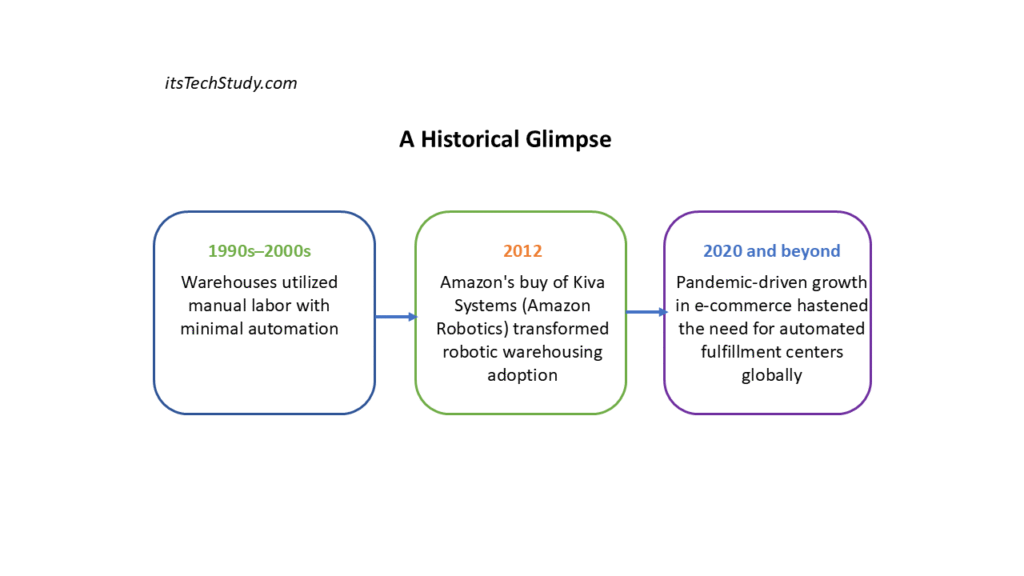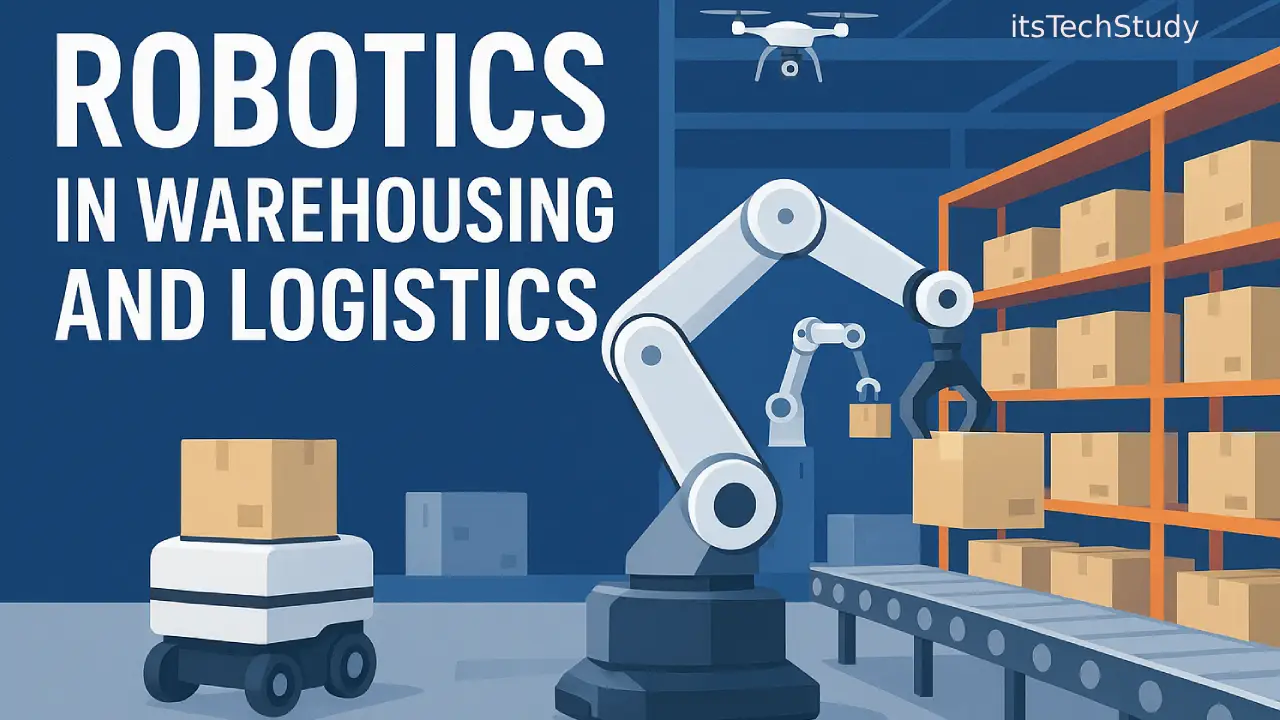Introduction: Why Robotics Technology is Transforming Warehousing and Logistics
Warehousing and logistics have historically been the backbone of international commerce. From merchants storing commodities in granaries in ancient times to today’s distribution centers, the mission has been consistently the same: bring products faster, more securely, and cheaply.
But today’s supply chains are confronted by issues never before encountered. As e-commerce skyrockets, customer demands for same-day shipment growing, and the worldwide labor shortage forcing companies to reconsider operations, old ways cannot hold on anymore.
The Technology of warehousing and logistics robotics comes in. Robots are no longer science fiction or factory arms but are proving to be a necessary tool for automating warehouses, executing repetitive tasks, minimizing human error, and maximizing efficiency.
2025 and beyond, robotics, Artificial intelligence (AI), and IoT will revolutionize the movement of goods from manufacturers to customers. Let’s discuss the trends, applications, advantages, and limitations of robotics in warehousing and logistics – and the future ahead.
The Rise of Robotics in Warehousing
A Historical Glimpse
- 1990s–2000s: Warehouses utilized manual labor with minimal automation.
- 2012: Amazon’s buy of Kiva Systems (Amazon Robotics) transformed robotic warehousing adoption.
- 2020 and beyond: Pandemic-driven growth in e-commerce hastened the need for automated fulfillment centers globally.

Trends Propelling Adoption Today
- E-commerce Expansion: With billions of online orders each day, speed and precision are essential.
- Labor Shortages: Robotics serves as a gap filler following an aging workforce and high turnover.
- Cost Pressures: Businesses turn to automation to cut operational expenditures.
- AI Breakthroughs: Smarter robots are capable of adapting, learning, and performing demanding tasks.
- Sustainability Targets: Energy-efficient robots minimize waste and emissions.
Principal Uses of Robotics in Logistics

- Automated Guided Vehicles (AGVs) and Autonomous Mobile Robots (AMRs)
- They transport products between warehouses, usurping the role of forklifts and manual pickers.
- AGVs travel along predetermined paths (such as rails or wires).
- AMRs employ AI and sensors for adaptable navigation.
- Robotic Picking and Packing
- Robot arms with computer vision can select, sort, and pack products of different sizes and shapes with high accuracy.
- Inventory Management Robots
- Ground and aerial robots read barcodes, monitor inventory levels, and minimize human mistakes during inventory counts.
- Sorting and Conveyor Robotics
- Conveyor systems and sortation robots speed up order processing, with packages delivered to the correct location.
- Last-Mile Delivery Robots
- While still in the development stages, self-delivery drones and robots are piloting quicker, touchless delivery mechanisms within urban centers.
Robotics in Warehousing – Strengths and Weaknesses
Advantages
- Increased Efficiency: Robots work 24/7 with little downtime.
- Accuracy: Fewer picking and shipping mistakes.
- Cost Savings: Reduced operation and labor costs in the long run.
- Scalability: Scale up automation quickly to cope with seasonal spikes.
- Safety: Lower workplace injuries by automating dangerous tasks.
Weaknesses
- High Upfront Cost: Expensive installation and infrastructure overhaul.
- Job Displacement Issues: Less room for manual laborers.
- Maintenance Requirements: Periodic upgrades and maintenance needed.
- Sophisticated Integration: Needs trained experts to operate systems.
Comparison: Traditional Warehousing vs. Robotic Warehousing
| Feature | Traditional Warehousing | Robotic Warehousing |
|---|---|---|
| Labor Dependency | High reliance on human workers | Automated with minimal staff |
| Efficiency | Slower, prone to human errors | Faster, highly accurate |
| Scalability | Difficult during demand spikes | Easily scalable with robots |
| Cost Over Time | Higher operational costs | Lower long-term costs |
| Safety | Higher risk of accidents | Improved workplace safety |
How Robotics Increases Supply Chain Efficiency
- Faster Order Fulfillment – Robots decrease lead times from days to hours.
- Real-Time Tracking – IoT integration offers transparency and visibility into inventory.
- Energy Efficiency – Automated processes use less power than traditional procedures.
- Reduced Waste – Streamlined processes reduce material and packaging waste.
- Customer Satisfaction – Speed and precision result in improved customer experience.
Future of Robotics in Warehousing and Logistics
In the future, several innovations will shape the next decade:
- AI-Powered Robots: Robots having the ability to make independent choices and learn new tasks.
- Collaborative Robots (Cobots): Cobots are robots designed to collaborate with human workers safely.
- Green Warehousing: Green- powered robots using renewable energy.
- Blockchain Integration: Increasing transparency as well as security for robotic-driven supply chains.
- Drone Networks: Disrupting last-mile delivery across urban and rural areas.
By 2030, according to experts, more than 60% of warehouses will be deploying robots and AI-powered automation as best practice.
Practical Tips for Businesses Contemplating Robotics
- Start Small: Begin with module-based automation solutions such as AMRs.
- Analyze ROI: Compare long-term cost savings to upfront investment.
- Train Workforce: Upskill staff to operate and maintain robotics systems.
- Select Scalable Solutions: Make sure your automation scales with your business.
- Prioritize Integration: Pick robotics solutions that integrate nicely with your warehouse management system (WMS).
Conclusion: Robotics as the Future of Supply Chains
Robotics in warehousing and logistics is no longer a futuristic idea – it’s today’s reality. By enabling faster, safer, and more efficient operations, robotics is addressing global supply chain challenges and preparing businesses for the demands of tomorrow.
Although there are high prices and integration issues, the advantages greatly outweigh the disadvantages. Companies that implement robotics today are not merely keeping pace with the competition — they’re leading the way for technology in logistics in the future.
The bottom line is clear: automation is not eliminating jobs but augmenting them, building brighter, safer, and greener supply chains for the future.
FAQs on Robotics in Warehousing and Logistics
Q1: Are robotics appropriate for small warehouses or just large corporations?
Ans: Robotics solutions are now available in scalable formats, which makes them affordable for small and medium warehouses, not only industry players.
Q2: How costly is warehouse robotics to implement?
Ans: Initial investment ranges broadly (tens of thousands to millions of dollars), but the ROI tends to offset the investment within 2–5 years.
Q3: Do warehouse robots eliminate human involvement entirely?
Ans: Not completely. Robots perform repetitive, risky, or time-consuming work, leaving humans to make decisions and solve complicated problems.
Q4: Which industries gain the most from robotic logistics?
Ans: E-commerce, retail, pharmaceuticals, manufacturing, and third-party logistics (3PL) providers are some of the greatest beneficiaries.
Q5: Can robots cope with unforeseen changes in operations?
Ans: With AI incorporation, advanced robots can switch to changed routes, product variations, and workflow interruptions with high agility.
Q6: Is warehouse automation eco-friendly?
Ans: Yes. Robotics often reduces energy consumption and waste, aligning with sustainability goals.












No Comments Yet
Be the first to share your thoughts.
Leave a Comment